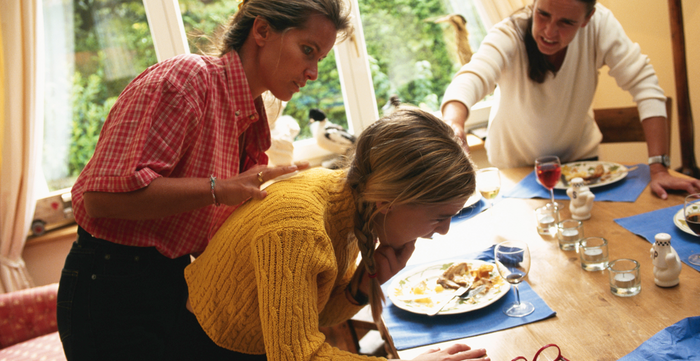Key points
- Children often choke on small items, particularly during the holiday season when small toys and decorations are prevalent.
- The most common foods children choke on include hard candy, gum, meats, bones, and fruits and vegetables.
- Small objects like holiday decorations, jewelry, coins, and magnets pose a choking risk, especially for toddlers.
- Parents and caregivers should be aware of choking hazards, supervise children, know where the nearest medical clinics are, and learn CPR and the Heimlich Maneuver.
- The article emphasizes the importance of supervision, knowing the location of the nearest emergency medical care clinics, and learning CPR and the Heimlich Maneuver to prevent choking incidents.

Food Hazards
Halloween officially begins the holiday season and many things from foods to objects can cause a child to choke. Boston.com's Dr. Claire McCarthy reports a study by the Academy of Pediatrics where researchers compiled a list of foods that children choked on most. These top five foods include:
- Hard candy
- Gum
- Meats
- Bones
- Fruits and vegetables.
Pumpkin seeds are also a big choking hazard so supervise your child when eating these.
Small Object Hazards
The holiday season also offers tons of small object toddlers and tweens can easily choke on. Some items include small holiday decorations like plastic bugs (spiders and beetles) or small embellishments on holiday decorations like flowers and buttons. Toddlers may choke on small pieces of jewelry like rings or earrings. Coins and magnets are also choking hazards. Monitor toddlers around these items and be sure they don't place them in their mouths. If they do, find an urgent care center near you to obtain treatment. A good rule of thumb for toddlers is if it's smaller than their hands and mouth, and sparkly or colorful, they probably will attempt to eat the item or place the item in their mouths.
Holiday Activities
It's easier than you think for children involved in holiday activities like bobbing for apples or playing with small building blocks to choke.
Bobbing for apples is not only competitive, there's also a danger of water choking or drowning. Small building blocks in wood or plastic are also a cause for concern.
Baby Center offers great tips on first aid for choking and CPR, however, if your child is choking on water, food or toys, call 9-1-1 or take your child immediately to a walk-in clinic to obtain the appropriate medical treatment.
Stocking Stuffers
Many parents are tempted by school kits that include small erasers in a variety of colors, pencils, pens and paper clips. Once home, they find the kit doesn't fit inside the stocking and will take the items out of the packaging and drop them one at a time into stockings. Unfortunately, Christmas morning is a busy time but it's extremely important to supervise your child with small items, especially if they are toddlers. Leave school kit items or kits that contain beads or other small objects inside the packaging they came in and sit down with your child when they open the kit.
Teen Choking
Choking hazards for teens often results from pranks or jokes. A teen may be challenged to swallow a small item. Or, they may place fruits or vegetables inside their mouths in an unsafe way attempting to be funny. Cafeteria or lunch foods are commonly used by the jokester or prankster dare.
It's important for teachers to know about the retail clinics near schools so proper medical care can be obtained if teens are choking. The teachers should also be skilled in CPR.
Choking is unexpected and happens easier than you think. Have a choking plan ready and speak with your physician about how to perform the Heimlich Maneuver to get objects out of throats.
To prevent choking hazards, remember to supervise children, know where the nearest emergency medical care clinics are near you, and learn CPR for kids as well as the Heimlich Maneuver.
FAQs
What are some common foods that children choke on?
The most common foods include hard candy, gum, meats, bones, and fruits and vegetables.
What small objects pose a choking risk for children?
Small objects like holiday decorations, jewelry, coins, and magnets are common choking hazards.
What precautions can be taken to prevent choking?
Supervise children, especially around small objects, know where the nearest medical clinics are, and learn CPR and the Heimlich Maneuver.
What should be done if a child is choking?
Call 9-1-1 or take the child to a walk-in clinic immediately. If trained, perform the Heimlich Maneuver or CPR.
Are teenagers at risk of choking?
Yes, teenagers can also choke, often as a result of pranks or jokes. Teachers should be aware of nearby clinics and be trained in CPR.
What are some choking hazards for teenagers?
Choking hazards for teenagers often result from pranks or jokes, such as being dared to swallow a small item or placing fruits or vegetables inside their mouths in an unsafe way.
What can be done to prevent choking in children?
To prevent choking in children, it's important to supervise them, know where the nearest emergency medical care clinics are, and learn CPR for kids as well as the Heimlich Maneuver.
What is the Heimlich Maneuver and why is it important?
The Heimlich Maneuver is a first aid procedure used to treat upper airway obstructions (or choking) by foreign objects. It's important because it can help get objects out of throats and potentially save lives.

